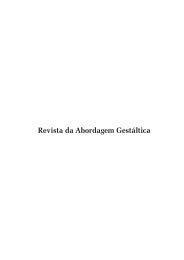Revista da Abordagem Gestáltica - ITGT
Revista da Abordagem Gestáltica - ITGT
Revista da Abordagem Gestáltica - ITGT
You also want an ePaper? Increase the reach of your titles
YUMPU automatically turns print PDFs into web optimized ePapers that Google loves.
D i s s e r t a ç õ e s e T e s e s<br />
<strong>Revista</strong> <strong>da</strong> Abor<strong>da</strong>gem <strong>Gestáltica</strong> – XVIII(2): 249-250, jul-dez, 2012<br />
Nayara Q. M. Sousa<br />
had a great influence in developing the structure and the state organization that<br />
earned them enormous prestige and power within the social environment. This feature<br />
associated with the struggle for independence and professionalism of the category<br />
generated a distance of judges with the public, and training for the judges based on<br />
the Cartesian method of doing science, which not accompanied the social changes<br />
brought by modernity, has enlarged this distance, generating a dissatisfaction with the<br />
performance of the Judiciary, including the labor sector. The increased conflictuality<br />
that caused by the changes implemented in the modern world requires rapid and<br />
effective responses of the judiciary, social as peacemaker. In this scenario, the means<br />
of conflict resolution should be privileged, that beyond the Judiciary of relief, resolve<br />
the dispute within society. Reconciliation has been promoted as the best and quickest<br />
solution to the lawsuits, so they need to be improved. Humanizing is an alternative<br />
approach to the judiciary of the citizen and helping in the mission of pacifying the<br />
conflict, for it promises the improvement of the person to cope better in society, in a time<br />
when the isolation and the contradictions seem to reach the modern man. This study<br />
aimed to identify the direction of the relationship between the judge and the parties,<br />
through an existential phenomenological research, using as a methodological tool, the<br />
version of meaning, to collect <strong>da</strong>ta. Results and discussion show that the speech of<br />
judges and parties of the axes of meanings emerged that reveal the feelings of each<br />
search, including specific thematizations Judges; axes that are communicated in the<br />
experiences of the parties and others axes which are peculiar to each part in particular.<br />
Analyzing these units of meaning they can trace connections to the literature review,<br />
highlighting the need to improve the judicial activity and promote a reflection on the<br />
postures adopted in the Judiciary of the Paraiba. This Search concluded by suggesting a<br />
new perspective to humanize the conciliatory attempt, taking the fun<strong>da</strong>mentals of the<br />
Person Centered Approach to qualify and deploy the conciliation within the Judiciary<br />
proposing the conciliation a humanist.<br />
Keywords: Reconciliation Humanist. Judiciary. Phenomenological Research. Version of Sense.<br />
Person Centered-Approach.<br />
Texto completo: http://www.unicap.br/tede/tde_arquivos/4/TDE-2011-06-07T155431Z-395/Publico/<br />
dissertacao_nayara_queiroz.pdf<br />
250




